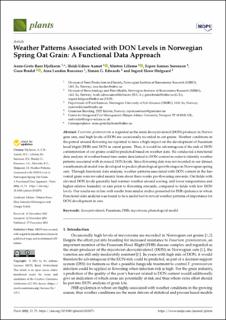Weather Patterns Associated with DON Levels in Norwegian Spring Oat Grain: A Functional Data Approach
Hjelkrem, Anne-Grete Roer; Aamot, Heidi Udnes; Lillemo, Morten; Sørensen, Espen Sannes; Brodal, Guro; Russenes, Aina Lundon; Edwards, Simon G.; Hofgaard, Ingerd Skow
Journal article, Peer reviewed
Published version
Permanent lenke
https://hdl.handle.net/11250/3001253Utgivelsesdato
2022Metadata
Vis full innførselSamlinger
Sammendrag
Fusarium graminearum is regarded as the main deoxynivalenol (DON) producer in Norwegian oats, and high levels of DON are occasionally recorded in oat grains. Weather conditions in the period around flowering are reported to have a high impact on the development of Fusarium head blight (FHB) and DON in cereal grains. Thus, it would be advantageous if the risk of DON contamination of oat grains could be predicted based on weather data. We conducted a functional data analysis of weather-based time series data linked to DON content in order to identify weather patterns associated with increased DON levels. Since flowering date was not recorded in our dataset, a mathematical model was developed to predict phenological growth stages in Norwegian spring oats. Through functional data analysis, weather patterns associated with DON content in the harvested grain were revealed mainly from about three weeks pre-flowering onwards. Oat fields with elevated DON levels generally had warmer weather around sowing, and lower temperatures and higher relative humidity or rain prior to flowering onwards, compared to fields with low DON levels. Our results are in line with results from similar studies presented for FHB epidemics in wheat. Functional data analysis was found to be a useful tool to reveal weather patterns of importance for DON development in oats.
